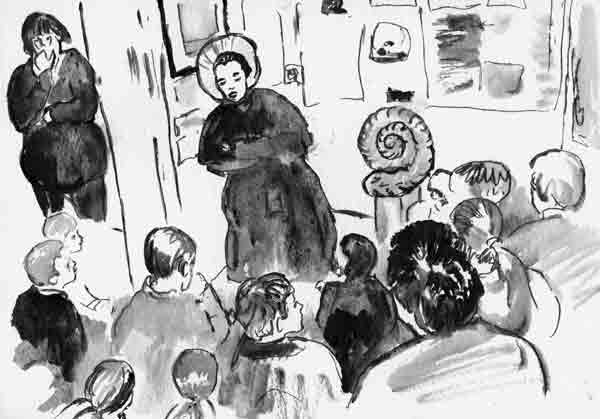The Lyme Maze Game

Mary Anning was a humble-born Lyme woman and a founder of the science of palaeontology. Here is the extraordinary sight of a double-decker bus named "Mary Anning" (actually it's one of the buses of the X53 coastal line) looming around the tight corner of Bridge Street and blocking all other traffic, on Mary Anning Day (March 18) in 2005, with "Mary Anning" herself aboard and greeting the crowd, which has been listening to speeches about her from the steps of the Guildhall,
—including this tribute by the Town Crier of Dorchester, Alastair Chisholm (standing in for the Town Crier of Lyme Regis, absent at the time): She sells sea shells on the sea shore And here is "Mary Anning" (variously named in local papers afterwards as Miriam Cooper, Miriam Copper, or Lizzie Hobley) in the museum, talking in bright Dorset dialect about fossils to children from a school in Charmouth, who then went on a treasure hunt around the display cases. (I'm afraid the item most eagerly sought was the "table made from dinosaur poo".)
The real Mary Anning was born in 1799. As a baby she was dull or retarded, but when she was eighteen months old a nurse took her to see a riding display in a field. A thunderstorm broke, the nurse and two other women sheltered under an elm, it was struck by lightning, the three women were killed, the baby was carried home and bathed in warm water and revived. People said that the electric jolt must have enlivened her little brain. Unlike many working-class children she went to school and could write letters. She was one of nine children, several of whom died in infancy, of Richard and Mary Anning. Their house was in Cockmoile Square, which opened off Bridge Street and is now covered by the museum. Father Richard was a carpenter, but used to pick up fossils from the beach to sell as curiosities, and Mary and her older brother Joseph helped. In late 1809 or early 1810 Richard, walking back from Charmouth at night, took a short cut and fell down a cliff; he died of tuberculosis in the summer of 1810, leaving his family in poverty. It was Joseph who in 1811 found a fossil head which he thought was a kind of crocodile. He asked Mary to keep a look out for the rest of the skeleton; she did, and found it the next year after a storm had loosened more rock and exposed it. Only thirteen, she supervised the digging, and the great relic was sold and displayed in London. It was what came to be called an ichthyosaur (Greek ichthys, "fish", and sauros, "lizard"): a reptile that had become adapted to living in the sea, about two hundred million years ago. And Mary found the first plesiosaur in 1824, and in 1828 the first complete dimorphodon (a gliding lizard). And among the fossils were rounded lumps that no one could explain until Mary noticed that they were also found inside skeletons, and must be fossilized dung. They were learnedly dubbed coprolites (Greek kopros, "dung", and lithos, "stone"). The great storm of 1824—"a scene of horror" said Mary in a letter to a friend—destroyed her house, and most of the Cobb. In 1826 she opened a new shop in Broad Street; visitors described it as like a museum, and dirty with dust from the fossil-cleaning. The customers who came to buy included in 1844 the king of Saxony. The work of searching for fossils on the crumbling cliffs and between the racing tides was rough and dangerous. Mary always took along her black-and-white dog Tray, known to us from her sketches; he guarded the items she had found while she looked for more. He was killed when part of a cliff fell on him. She sometimes took visitors fossiling; one of these in 1834, Anna Maria Pinney, became so frightened as they ran from a wave that Mary had to carry her. Once on the beach Mary placed flowers on the body of a beautiful woman washed up dead from a shipwreck off Portland. Sometimes she set out before dawn to catch the falling tide; in 1833 when hurrying through narrow Bridge Street in the dark she met a horse-drawn cart that crushed her against a wall. Besides finding the fossils, she had to do the heavy work of lifting them and, in her backroom workshop, the protracted skilful work of chipping them free from their embedding rock. A poor woman, she was sought out by wealthy collectors and established geologists; pious, she contributed to a science that shocked those who believed the world had been created a few thousand years ago and reshaped by a flood. Mary did not marry; died of cancer in 1847 at the age of forty-seven. In St. Michael's churchyard is the grave she shared with her brother Joseph and three of their siblings who died as babies. One more bit of doggerel, the last of six stanzas of an ode to her by John Kenyon, 1838 (quoted by Jo Draper in Lyme Museum Piece magazine, 2005 Dec.): True Mary! We—earth-born—must go, |

